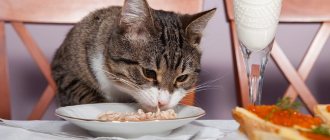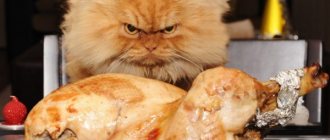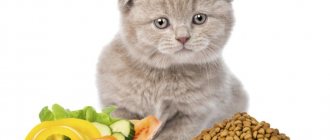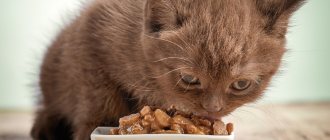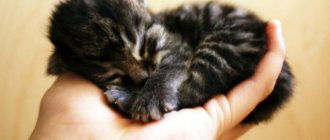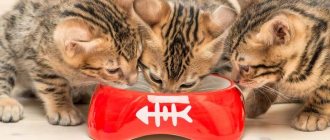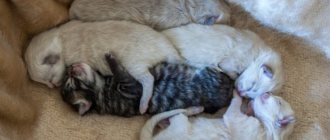In cases where small kittens, often newborns, are left without a mother, it is necessary to look for a replacement for natural feeding. The best option is for another animal to take care of the kittens, including feeding.
But if it is not possible to find a new mother for furry babies, then it is worth using special mixtures intended for kittens. The feeding process includes several main points. All of them are described in detail in this article.
Dishes for feeding kittens
You can feed kittens from bottles and syringes purchased at the pharmacy. Often, an ordinary disposable syringe without a needle is used for this purpose. The syringe must be replaced with a new one throughout the entire feeding period. Its lower end is sometimes rounded, treated with thin sandpaper or a file. Even in cases where the kitten initially does not immediately like this method of feeding, he will gradually get used to it and even begin to suck out the contents of the syringe.
A homemade device in the form of a bottle of used drops and a pipette is also suitable for feeding kittens. A bottle of eye drops, for example, chloramphenicol drops, is ideal. It resembles a baby bottle, and the top part is adapted for a nipple made from the rubber part of a pipette. Before use, all items are washed well and must be sterilized. Abandoned kittens have very weak immunity, so bottles and nipples must be sterilized and the syringe replaced with a new one.
Tips for feeding a kitten
Raising kittens without a cat, especially for the first time, requires a lot of effort, patience, and skills. The following tips will help you overcome difficulties and tell you how to get out of a difficult situation.
- The kitten has eaten the amount allotted for its age, but continues to suck. How to proceed? Immediately a fear arises - he doesn’t have enough, he hasn’t eaten enough, I must add. It's worth checking your tummy. Round and elastic, it indicates that there is enough food. The kitten just got carried away, or didn’t realize that it was full.
- The baby does not drink the dose prescribed for his age. Perhaps he is sick. Or this is a feature of the body - it eats less food. If he behaves on par with the other kittens and does not seem weak, then everything is fine. Otherwise, you need to show it to a specialist.
- The kitten must be fed at night. This is a feature of the body of a newborn, like a baby. If this is not done, digestion will be disrupted and health problems will arise. At night, kittens will meow, look for food, and not sleep.
- The portion should be divided into 2 times. Initially, the baby pounces on the food and sucks greedily. Having drunk it all, he does not realize that he is full and feels hungry. Then proceed as follows. They feed one kitten; when it drinks half of it, they stop feeding it. They move on to the second baby. They do the same. Then they return to the first baby again. In this case, he will eat calmly, and the feeling of fullness will come on time.
- The mixture is prepared in portions before feeding. The digestive system is such that it cannot tolerate “yesterday’s” or “morning” food. There is bloating, fermentation, pain. It is better to heat food in a water bath.
- The kitten does not take the pacifier, pipette, or the tip of the syringe; you must carefully insert it into the mouth and squeeze out a little of the mixture. To stimulate sucking, you need to stroke his back and forehead.
- When feeding a kitten, you need to make sure that the head does not tip back too much. In this case, he does not have enough breath, which leads to difficulties. The kitten may choke, choke, or suffocate.
- To determine whether the baby is full or not, you need to observe his behavior. A well-fed kitten will turn away from the pipette and calmly go to bed. A hungry baby will squeak, suck on his brothers, and look for a pacifier.
- It is better to buy milk for preparing the mixture at the market, not in the store. In this case, you can be sure of its natural origin and quality. If the milk contains food additives, preservatives, or water, it will not benefit the kitten. In addition, the mixture prepared according to the recipe will be low in calories, the baby will not get enough of it.
Feeding a kitten without a cat is a very labor-intensive and lengthy process. You need to quit all your business, not go to work, feed the babies every 2 hours day and night. The sacrifices must be justified.
An interesting fact remains that when such a situation arises in rural areas, kittens are fed fresh cow's milk from a pipette for literally a week. When they get to their feet, offer a small bowl. No special care. As a result, they grow up alive, playful, and healthy. They determine their own norm.
https://www.youtube.com/watch?v=r2ZCM15oLgw
Temperature and dose of milk
Depending on its size, the kitten is given approximately 2.5 milliliters of the mixture, adding half a milliliter evenly after two feedings. After three days, the baby is able to drink up to 10 milliliters of milk. The temperature of the mixture should not exceed 38-39°C. That is, the mixture should not be hot, nor should it be cold. You can check whether the formula is suitable for feeding a kitten by dropping it on your wrist. The warm mixture does not burn.
Often, when feeding, they adhere to the following regimen, depending on age: - 1 week - approximately 30 milliliters per 100 grams of weight; - at 2 weeks 35 milliliters per 100 grams of weight is given; - at 3 weeks the norm is 40 milliliters per 100 grams of weight; - from 4 weeks - ranging from 48 to 53 milliliters per 100 grams of weight.
Cooking Features
It is necessary to pay attention to the temperature of the food. Since cold food disrupts digestion, hot food burns the oral cavity. From the first days of feeding, the temperature should be 37 degrees - an approximate indicator for the kitten’s body.
Lower this level every week. By the end of the month, the mixture should be at room temperature - 24 degrees. If there is nothing to measure, proceed as follows. The bottle is pressed against the bend of the elbow, nothing is felt - neither cold nor heat - you can give it to the kitten.
Calculation of the amount of mixture
You need to get a measuring spoon to properly prepare food for newborns. The amount of feed is calculated taking into account body weight.
- Days 1–4 – 30 ml of the prepared mixture per 100 g of weight;
- 5 –13 – 38 ml;
- 14 –24 – 46 ml;
- 25 –35 – 53 ml per 130 g body weight.
Feeding kittens
In order for babies to develop normally, they need a proper diet with the obligatory presence of vitamins. To create mixtures for kittens, you should get a small measuring cup. You also need to know how much weight of a particular component a teaspoon or tablespoon can hold. This knowledge will be useful when preparing mixtures.
All kitten formula recipes include dairy products. At best, food that replaces cat milk is purchased at pharmacies and pet stores. However, this option is not always suitable for everyone. Therefore, people use self-created mixtures to feed kittens.
To create a milk formula for a kitten, goat's milk with a fat content of up to 2.5% or cow's milk - 1.5% is often used. Once every 2 days, you can add the yolk of quail eggs and 2-3 drops of syrup consisting of 1 teaspoon of water and 1 teaspoon of sugar to the milk.
When the kittens open their eyes, they should be given any meat mixture intended for human children. At first, it replaces one milk feeding. A day later another one and so on.
The meat mixture (2.5 ml) should be diluted with one teaspoon of water, stirring until it becomes liquid sour cream. Kittens are fed through a syringe or pacifier. The solution is stored in the refrigerator for 24 hours.
Homemade food or store-bought kitten food?
Arguing about which diet is best for a growing body is a thankless task. There will be plenty of supporters of feeding homemade food, as well as opponents. Both methods of eating have a number of advantages and disadvantages, for example, cooking at home will cost less than buying specialized food, but will the owner dare to cook every day? Those who advocate for home-cooked food are stopped by the price of store-bought quality food. What to feed small cats and cats is decided by each owner, based on his own ideas and income.
- Popular foods
- New
- Stock
GO grain-free food for kittens and cats with sensitive digestion with fresh duck
GO grain-free food for kittens and cats with sensitive digestion with fresh duck
Price: from 1320
Dry food GO (Go) for kittens and cats with lamb and wild boar meat
Dry food GO (Go) for kittens and cats with lamb and wild boar meat
Price: from 1360
Dry food GO (Go) for kittens and cats with salmon and cod
Dry food GO (Go) for kittens and cats with salmon and cod
Price: from 1227
Proplan for canned food for kittens CHICKEN
Proplan canned food for kittens CHICKEN High content of chicken Meat and meat by-products (of which 14% chicken), fish and fish by-products, minerals, components...
Price: from 73
Canned food Four-legged gourmet Puppy pate with poultry
Canned food Four-legged gourmet Puppy pate with poultry Ingredients: poultry meat, liver, tripe, rice flour (5%), vegetable oil, bone meal (1%), table salt, gelling agent, water…
Price: from 30
Tetra Gammarus fish food
Tetra Gammarus Fish Food Healthy complete food for turtles containing Gammarus. Triangle Healthy complete turtle food containing Gammarus….
Price: from 107
8in1 Delights Bone Strong L/160g
8in1 Delights Bone Strong L/160g Chewable hard bone for dogs with chicken Pressed chewable bones with chicken provide especially…
Price: from 405
TetraAqua ToruMin
TetraAqua ToruMin Liquid conditioner that creates a black water effect for freshwater aquariums. Liquid conditioner that creates the effect of the so-called...
Price: from 275
Plastic carrier for transporting animals “Tourne” with clear plast. door
Plastic carrier for transporting animals “Tourne” with clear plast. door
Price: from 655
BOSCH Adult salmon with potatoes
BOSCH Adult salmon with potatoes A complete balanced diet for adult dogs with an average activity level. Optimal for an adult city dog…
Price: from 603
Dry food for adult dogs Hill's SP Canine Adult AFit Lamb & Rice
Hill's SP Canine Adult AFit Lamb & Rice Hill's™ Science Plan™ dry food for adult dogs is a complete, precisely balanced diet made from high-quality ingredients…
Price: from 1552
Dry food for adult cats Hill's SP Feline Adult Optimal Care Chicken
Dry food for adult cats Hill's SP Feline Adult Optimal Care Chicken Hill's™ Science Plan™ is a complete, precisely balanced diet made from high-quality ingredients…
Price: from 300
ALL FOOD FOR KITTENS
Perhaps expert advice will help you find the right solution:
- Consider financial possibilities: it makes sense to switch to a home cooking method if good specialized nutrition is expensive.
- Buying cheap food simply means harming your small pet; The composition of ready-made food advertised on TV is distinguished by the abundance of vegetables, meat and bone meal, and the addition of flavoring additives that are so attractive to cats. An unhealthy composition will result in problems with health and well-being.
- Kitten food is an ideal solution if the owner works a lot, stays late, is tired and does not have the strength to prepare a delicious dinner for the baby; take out the bag and you're done.
- Natural products are undoubtedly healthier than store-bought cat food. When choosing a method of feeding homemade food, remember: you will have to prepare a variety of dishes to cover your pet’s daily need for microelements. Make up for the deficiency with vitamin supplements. This incurs certain financial costs, but the finished pates and granules are balanced, the composition has the necessary substances for growth and harmonious development.
- A diet based on meat and cereals is ideal for a growing body. Physiologically, the intestines of animals are adapted to process hard protein foods, so soft foods (pates) become a common cause of constipation and diarrhea.
Kitten formula recipes
1. In a liter of boiling milk, stir 1 teaspoon of bone meal, 200 milliliters of condensed milk without sugar and 100 milliliters of water. The resulting mixture is filtered and cooled.
2. Mix 2 egg yolks, a glass of milk, 1 teaspoon of vegetable oil, 1 drop of Tertravit or Trivit vitamins.
3. Use 0.5 teaspoon of unrefined vegetable oil as an additive, “Tertravit” up to 0.3 milliliters, “Vitom” - on the edge of a knife. Without additives, the mixture can stand in a cold place for 24 hours. When additional components are added to half the solution before feeding, the mixture is filtered through a sieve and heated in a sterile container immersed in warm water.
4. Goat or cow's milk is mixed with protein in a ratio of 4 to 1 and whipped until smooth.
5. Mix 50 ml of raw and 50 ml of boiled milk, 0.5 yolk and 1 tsp. corn oil.
6.1 egg yolk, 0.5 l. concentrated milk is mixed until smooth.
7. 200 ml of cream with 10% fat content is diluted with water 1:2. A glass of 10% cream should be diluted with boiled water in a 1:2 consistency.
8. For weak babies, the mixture is prepared from half a glass of milk with a fat content of 3.2%, 20 ml of glucose (5%) and 1 yolk.
What milk to feed kittens
If a cat cannot feed her offspring, the most suitable option is to find another dairy mother for him. And before cat milk substitutes were invented, many people preferred to feed their pets with homemade cow's or goat's milk.
Goat milk is still considered an excellent option for feeding a small animal. It contains a large number of vitamins and lactobacilli, which help strengthen the pet’s body.
A kitten should not be fed cow's milk
Note! Cow's milk has always been unsuitable for kittens. Today, experts prohibit its use for feeding, and goat milk is recommended to be diluted with warm water in a 1:1 ratio.
